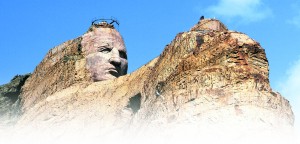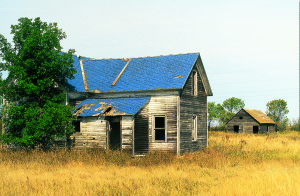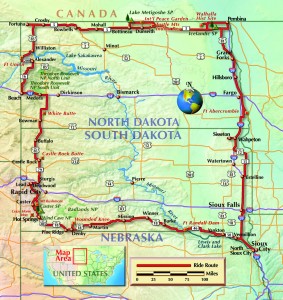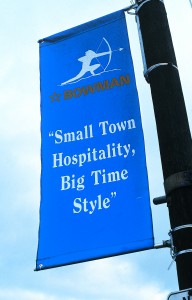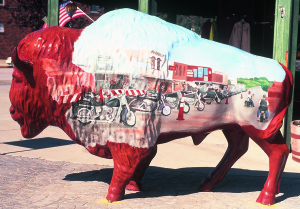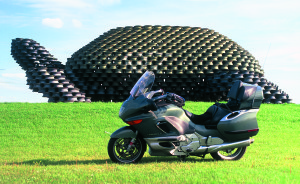As a motorcyclist who enjoys vacant, isolated roads, I stared longingly at the Dakotas on my National Geographic wall map while planning my next excursion. A childhood friend of my wife had recently moved to Sioux Falls with her family. The brother of a buddy who was a groomsman at my wedding 25 years ago had transplanted himself to Sioux Falls from California long ago. I figured I should check out the allure, but I also needed an angle to enhance the journey. So, much like my ride around the perimeter of Kansas (Rider, August 2004), I decided to circumnavigate the perimeter of North and South Dakota.
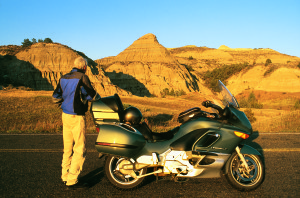
Fargo turned out betwixt and between, so I ended up starting there. North Dakota’s largest city is named for the co-founder of the famed Wells Fargo Express Company. It is also the hometown of baseball legend Roger Maris, and as a fan of the pastime I headed for the museum tribute to him in West Acres Mall. Not much else shakin’ in Fargo, if you discount the casinos, so afterward I pointed the Beemer’s nose northward up the Red River Valley on U.S. 81 paralleling Interstate 29.
Grand Forks stands along the Red River of the North, which provided flatboat transportation for farmers’ goods until the arrival of the Northern Pacific Railway in 1880. The great spring flood of 1997 displaced the entire population of Grand Forks (some 50,000), and ruined downtown historic buildings. The resilient folks went about rebuilding their lives by renovating and revitalizing. I headed for one resuscitated landmark, The Kegs Sloppy Joe Root-Beer Stand.
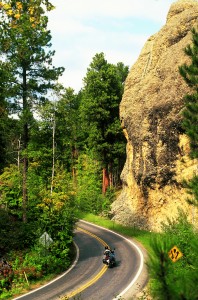
The next town at a Red River confluence is Pembina in the far northeastern corner of the state, where fur-trading voyageurs established trading posts. Strife among trappers and farmers resulted in the Massacre of Seven Oaks in 1816, when 20 settlers were killed. Nonetheless, Pembina (an Indian word meaning high-bush cranberry) became the center of European settlement in the state. Scandinavians and Icelanders were among the hearty immigrants who homesteaded here, and a Heritage Center in Icelandic State Park relates their story. The needlelike tower at the Pembina State Museum offers an expansive view over the drift prairie extending into
nearby Canada.
Drift prairie results from glaciers, and the receding hunks of ice scoured out Pembina Gorge just west of Walhalla. It’s only a slight dip in the land, hardly enough to swallow the Beemer. Route 5 westbound traces the prairie potholes and sloughs, havens for migrating waterfowl, and their raucous babble could be plainly heard above the hum of the engine. I’m told that most of the ducks in North America are hatched in this habitat. I didn’t park long, for I didn’t care to be nibbled to death.
Not an hour later I entered the lakes and streams, rolling hills and broadleaf forests of the Turtle Mountains near Rolla. The Turtle Mountains comprise the only woodland in the state, reason enough for quirky monuments and celebration. The world’s largest turtle squats just off State Route 5 in Dunseith, made completely out of old wheel rims. Another giant turtle sits astride a snowmobile in Bottineau. But these fanciful creations also serve to represent the Bill’s Terrapin, or mud turtle, that is part of the indigenous fauna hereabouts.
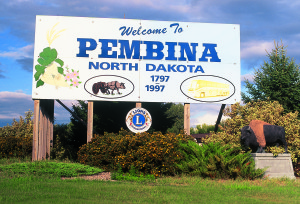
The Turtle Mountains add a natural beauty to the region, which is given even more impact by the appearance of the International Peace Garden. This colorful floral park was dedicated in 1932 as a memorial to friendship between the United States and Canada. Four towers rise 120 feet to symbolize the corners of the earth reaching common understanding. Serenity is further enhanced by the presence of a chapel and carillon chiming every 15 minutes. A more recent addition memorializes the devastation at the World Trade Center. With a campground and café on the grounds, I found it a most calming spot to stay.
West of Bottineau the Drift Prairie transitions to Great Plains, or what’s known geologically as the Missouri Plateau. Some travelers view this as flat, and consequently boring. But as William Least Heat Moon writes in Blue Highways, “Boredom lies only with the traveler’s limited perception and his failure to explore deeply enough.” I passed acre upon acre of sunflowers, their seedless heads dipping in forlorn resignation like the marching ranks of a defeated army.
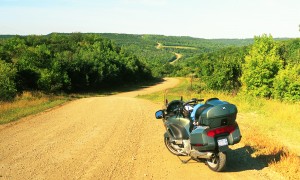
Austere State Route 5 beckoned toward a seamless horizon, vacant sky adding to the illusion of lost dimension. Chasing an ever-receding boundary and seemingly never gaining ground against a ceaseless, shoving wind intensified the disorientation. I searched for any landmark in order to regain perspective. The occasional abandoned farmhouse appeared like a derelict upon an eroded land. Such tumbledown homesteads commonly dot this vacated sector of semi-arid plains, leaving behind only ghosts wailing in the ever-present wind.
Fortuna lies in the northwest corner of the state like the remnant of a tattered rag. I quickly left the town headed south to shake the area’s depression and ended up retreating into the Mountain Man era at Fort Union. John Jacob Astor’s American Fur Company built Fort Union in 1828 to control the trading economy of the Northern Plains. It’s now a museum of the fur trade. A tradesmen’s building was reconstructed using an adz to square the beams and wooden pegs to hold them in place. A fire crackling in the mammoth stone fireplace and a ranger in a period outfit added to the authenticity.
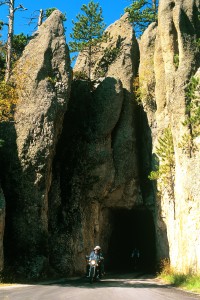
Riding out from this post I passed over the Missouri River where it joins the Yellowstone near the Montana border. I recalled camping along this confluence one year, only to awaken after an overnight rainstorm to find myself stuck in a quagmire of river bottom gumbo. I had to scoop muck from the wheel wells of the Beemer I was riding at the time. This Missouri River bottomland ooze, I eventually found out from a park ranger, is called bentonite, a mud that holds three to four times its weight in water and is used as a drilling lubricant.
State Route 16 pleasantly undulates for 60 miles across the Little Missouri Grasslands. I passed a solitary one-room schoolhouse and Lutheran church. Cows lined pastures against a dramatic backdrop of buttes. Farmers emptied their round harvesters of cylindrical hay bales. I began to spot herds of elk. Then I skirted Sentinel Butte, North Dakota’s second highest point, on my way into Medora, gateway to the South Unit of Theodore Roosevelt National Park.
A French nobleman, the Marquis de Mores, founded Medora in 1883, naming it after his young bride. The Marquis opened a meat packing
plant and built himself a chateau atop a hill. Young greenhorn Teddy Roosevelt soon arrived from New York on a hunting trip. He ended up staying and establishing a cattle ranch. However, blizzards during the winter of 1886-’87 all but destroyed the Dakota cattle industry, including Roosevelt’s enterprise and the Marquis’ meat processing venture. But the legacy of both lives on, and one is able to visit the Chateau with its original furnishings, and Roosevelt’s Maltese Cross cabin. I even took in a musical revue honoring Roosevelt at the Burning Hills Amphitheater, built into a natural bowl of the badlands.
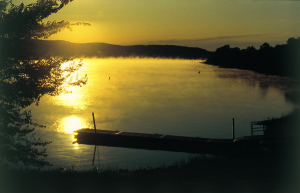
After a night camped in the solitude of the Badlands, I dropped down U.S. 85, virtually scraping North Dakota’s highest point White Butte, which rises 3,506 feet. An Indian archer’s silhouette pointed the way through Bowman, in North Dakota’s southwest corner. Then I slung down the arrow-straight highway back into open country in a rush to the Black Hills.
Unlike August when the Sturgis madness is in full swing, now in mid-September the road ahead and behind me lay vacant, urging me into the sweepers. Toe and shifter danced a tango as the Beemer pirouetted the hairpins and whirled around pigtail bridges on Iron Mountain Road. I nodded toward Messrs. Washington, Jefferson, Lincoln and Roosevelt, begging forgiveness for the snub; I’d visited years ago and was anxious to see how another stonefaced icon was progressing. After poking through tunnels and threading the granite needles of State Route 87, I encountered the Crazy Horse Memorial back on U.S. 385.
Sculptor Korczak Ziolkowski began blasting and chipping away his vision of Sioux warrior Crazy Horse in 1949 on Whiteface Mountain. Though overshadowed by Rushmore he chiseled on undeterred until his death in 1982 at the age of 74. Only the face is complete of an image that will include an outstretched arm and horse beneath, but his sons toil on without federal money, accepting only donations. Ziolkowski sympathized with the Indian and his brethren, who endured a string of broken treaties. When complete, perhaps generations from now, this image will serve as a counterpoint to the noted End of the Trail sculpture that depicts a warrior slumped in resignation.
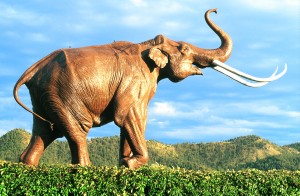
Although Westerners nearly wiped out the bison in a strategy to destroy Indian culture, there are still plenty along the wildlife loop through Wind Cave National Park. I was sure one of the bulls wanted to mate with the Beemer, and seemed awful jealous of me as it snorted threateningly. I made it out of there, skirting the buffalo chips, and finding refuge and refreshment in the far southwestern Dakota resort town of Hot Springs.
I left the Badlands along U.S. 18, entering grassland and woodland that delineates the Pine Ridge. The Black Hills were traditional hunting, worship and burial grounds for the Sioux until the discovery of gold, and treaties were then revoked. Today, the Pine Ridge Reservation serves as a reminder to their disenfranchisement. It’s ironic that Dakota is a Sioux word meaning friend, or ally.
Underscoring the plight of these Native Americans was the next site I visited, Wounded Knee. In December 1890 cavalry troops surrounded a band of Lakota Sioux, who were forced to march here, and began disarming them. A shot rang out and the slaughter began, with troops opening up with rapid-fire Hotchkiss guns, killing nearly 200 Sioux. The image of Chief Big Foot’s frozen body contorted in pleading anguish lives on in perpetuity. This massacre effectively ended the Indian wars. In 1973 an armed group of the American Indian Movement seized the site to protest Federal policies toward them. The standoff lasted 71 days and led to two deaths, but consciousness was raised anew about their plight.
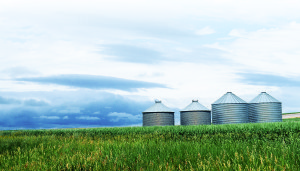
Route 18 now carried me across flat, featureless terrain past indistinguishable towns until I jumped the Missouri River again, and a series of border routes hooked me up with State Route 50 following the Vermillion River. I entered larger cities now, places like Yankton, cow capital of South Dakota, and Vermillion, home to South Dakota University and the National Music Museum. After I touched Sioux City, my final corner, I hightailed it north on I-29 to the next location named after an indigenous native tribe.
Sioux Falls is nestled in a giant horseshoe bend of the Big Sioux River, where the namesake falls tumble and cascade through and over a broad quartzite quarry. Many of the buildings in the downtown historic district, including the Old Courthouse, are constructed of stone harvested at this site. A bicycle trail follows a greenbelt that completely surrounds the river, with canoe access and fishing holes aplenty. Extensive parks make South Dakota’s largest city of nearly 200,000 more habitable and family friendly, according to my friends the Raffertys, who moved here for a job commitment but don’t intend to uproot themselves again, a testimony to the claim that Sioux Falls is one of America’s most livable cities.
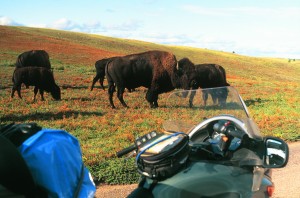
For the 100 miles from Sioux Falls to Watertown I’m riding a ridge along I-29 that offers occasional sweeping views into neighboring Minnesota. At the Sisseton exit I followed State Route 10 west for 10 miles to check out a lookout tower I saw from the distance. This observation post sits atop a continental divide overlooking the watershed where liquid runoff shoves the Red River northward, one of the few North American rivers that do flow upward, so to speak. Runoff from here also trickles south into the Bois De Sioux River bordering Minnesota, and pulls triple duty by quenching the Big Sioux River. I know for a fact this water cycle is prevalent after splashing through a gusting thunderstorm days earlier on my way to Sioux Falls, and just missing a tornado that touched down northeast of town two hours after I arrived!
I returned to Fargo taking back-country roads that led me past Fort Abercrombie, established in 1858 to guard wagon trains and steamboat traffic on the Red River. I’m back at the crossroads of what has always served as a major transportation route throughout the Northern Plains after some 2,000 miles. Now I’m ready to research the next prospect for one of these perimeter runs because they are fast becoming habit forming.
(This article Connecting the Dakotas: The Long Way Around North and South was published in the August 2009 issue of Rider magazine.)

